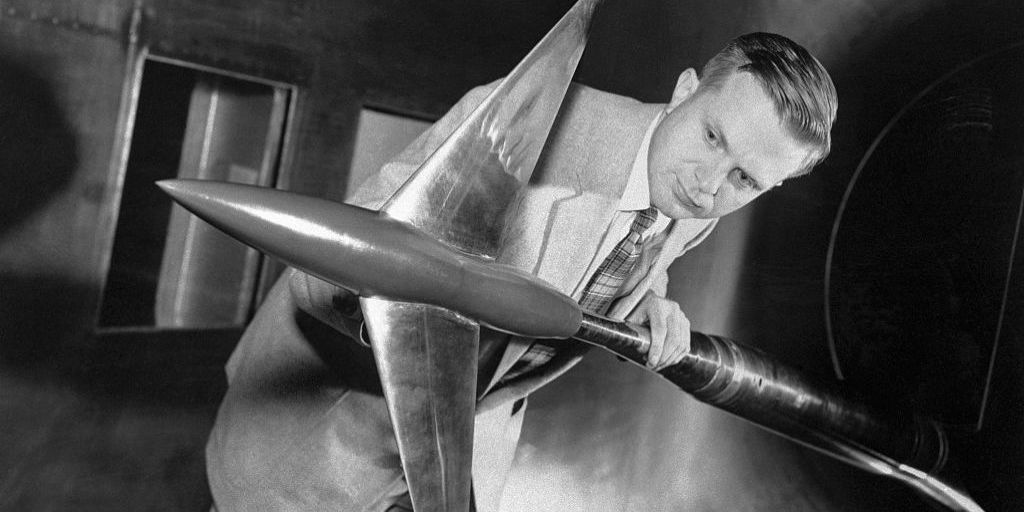No sir, you don't! You made an assumption that you understand aerodynamics by following F1 for over a decade. it don't work like that- otherwise, all University aero departments & wind tunnels in the world can be shut down immediately if we could churn out experts from simply sitting in front of the TV.
The area rule was a hard-fought discovery which was the result of painstaking labour from the late 40s to early 50s by some very very creative people & very fittingly for the assumption you make, they had to unlearn some of the aerodynamics they had previously learnt (
they also thought they knew!).
In late 1951, Whitcomb tested a swept-back wing-fuselage combination in the now-transonic Eight-Foot High-Speed Tunnel.
7 Tuft surveys, which used small pieces of yarn taped onto airfoil and fuselage sections, were conducted to look at airflow disturbances. Coverings with pressure-sensitive openings were put on model sections to determine the velocity of the air over particular areas, and Schlieren photographs were used to look at the shock wave characteristics of the model at transonic speeds.
8
The results, especially those revealed by the Schlieren photographs, showed that the shock waves created as the airflow approached the speed of sound were different and bigger than anticipated. Undoubtedly, it was the losses from these unexpected shock patterns that was causing the sharp increase in drag at transonic speeds. But the question of what was causing the shockwaves still had to be answered before researchers could try to find a way to combat the phenomenon.
Several weeks later, a world renowned German aerodynamicist named Dr. Adolf Busemann, who had come to work at Langley after World War II, gave a technical symposium on transonic airflows. In a vivid analogy, Busemann described the stream tubes of air flowing over an aircraft at transonic speeds as pipes, meaning that their diameter remained constant. At subsonic speeds, by comparison, the stream tubes of air flowing over a surface would change shape, become narrower as their speed increased. This phenomenon was the converse, in a sense, of a well-known aerodynamic principle called Bernoulli's theorem, which stated that as the area of an airflow was made narrower, the speed of the air would increase. This principle was behind the design of venturis,
9 as well as the configuration of Langley's wind tunnels, which were "necked down" in the test sections to generate higher speeds.
10
But at the speed of sound, Busemarm explained, Bernoulli's theorem did not apply. The size of the stream tubes remained constant. In working with this kind of flow, therefore, the Langley engineers had to look at themselves as "pipefitters." Busemann's pipefitting metaphor caught the attention of Whitcomb, who was in the symposium audience. Soon after that Whitcomb was, quite literally, sitting with his feet up on his desk one day, contemplating the unusual shock waves he had encountered in the transonic wind tunnel. He thought of Busemann's analogy of pipes flowing over a wing-body shape and suddenly, as he described it later, a light went on.
The shock waves were larger than anticipated, he realized, because the stream tubes did not get narrower or change shape, meaning that any local increase in area or drag would affect the entire configuration in all directions, and for a greater distance. More importantly, that meant that in trying to reduce the drag, he could not look at the wing and fuselage as separate entities. He had to look at the entire cross-sectional area of the design and try to keep it as smooth a curve as possible as it increased and decreased around the fuselage, wing and tail. In an instant of clarity and inspiration, he had discovered the area rule.
In practical terms, the area rule concept meant that something had to be done in order to compensate for the dramatic increase in cross-sectional area where the wing joined the fuselage. The simplest solution was to indent the fuselage in that area, creating what engineers of the time described as a "Coke bottle" or "Marilyn Monroe" shaped design. The indentation would need to be greatest at the point where the wing was the thickest, and could be gradually reduced as the wing became thinner toward its trailing edge. If narrowing the fuselage was impossible, as was the case in several designs that applied the area rule concept, the fuselage behind or in front of the wing needed to be expanded to make the change in crosssectional area from the nose of the aircraft to its tail less dramatic.
11
The mathematics of cross-section.

www.popularmechanics.com






